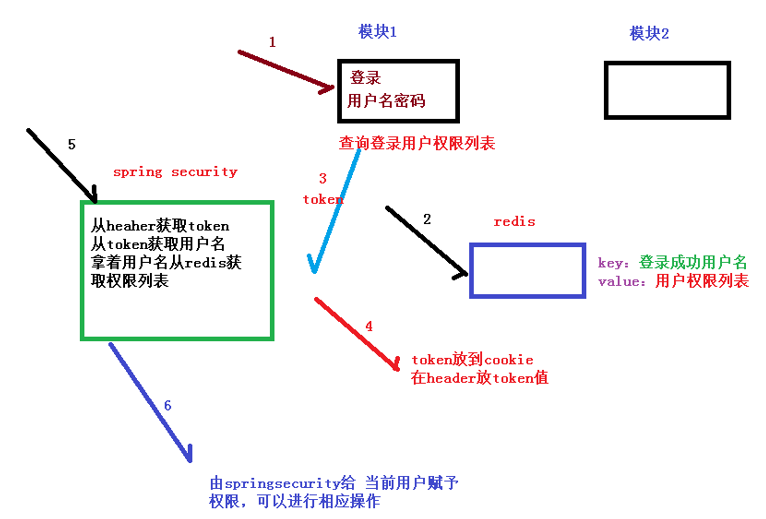一、Spring Security介绍
1、框架介绍
Spring 是一个非常流行和成功的 Java 应用开发框架。Spring Security 基于 Spring 框架,提供了一套 Web 应用安全性的完整解决方案。一般来说,Web 应用的安全性包括用户认证(Authentication)和用户授权(Authorization)两个部分。
(1)用户认证指的是:验证某个用户是否为系统中的合法主体,也就是说用户能否访问该系统。用户认证一般要求用户提供用户名和密码。系统通过校验用户名和密码来完成认证过程。
(2)用户授权指的是验证某个用户是否有权限执行某个操作。在一个系统中,不同用户所具有的权限是不同的。比如对一个文件来说,有的用户只能进行读取,而有的用户可以进行修改。一般来说,系统会为不同的用户分配不同的角色,而每个角色则对应一系列的权限。
Spring Security其实就是用filter,多请求的路径进行过滤。
(1)如果是基于Session,那么Spring-security会对cookie里的sessionid进行解析,找到服务器存储的sesion信息,然后判断当前用户是否符合请求的要求。
(2)如果是token,则是解析出token,然后将当前请求加入到Spring-security管理的权限信息中去
2、认证与授权实现思路
3、认证与授权实现思路图解

二、代码示例
1、pom依赖
<?xml version="1.0" encoding="UTF-8"?> <project xmlns="http://maven.apache.org/POM/4.0.0" xmlns:xsi="http://www.w3.org/2001/XMLSchema-instance" xsi:schemaLocation="http://maven.apache.org/POM/4.0.0 http://maven.apache.org/xsd/maven-4.0.0.xsd"> <parent> <artifactId>common</artifactId> <groupId>com.stu</groupId> <version>0.0.1-SNAPSHOT</version> </parent> <modelVersion>4.0.0</modelVersion> <artifactId>spring_security</artifactId> <dependencies> <!-- Spring Security依赖 --> <dependency> <groupId>org.springframework.boot</groupId> <artifactId>spring-boot-starter-security</artifactId> </dependency> <dependency> <groupId>io.jsonwebtoken</groupId> <artifactId>jjwt</artifactId> </dependency> </dependencies> </project>
目录结构

2、Spring Security的核心配置就是继承WebSecurityConfigurerAdapter并注解@EnableWebSecurity的配置。这个配置指明了用户名密码的处理方式、请求路径的开合、登录登出控制等和安全相关的配置
package com.stu.security.config; import com.stu.security.filter.TokenAuthenticationFilter; import com.stu.security.filter.TokenLoginFilter; import com.stu.security.security.DefaultPasswordEncoder; import com.stu.security.security.TokenLogoutHandler; import com.stu.security.security.TokenManager; import com.stu.security.security.UnauthorizedEntryPoint; import org.springframework.beans.factory.annotation.Autowired; import org.springframework.context.annotation.Configuration; import org.springframework.data.redis.core.RedisTemplate; import org.springframework.security.config.annotation.authentication.builders.AuthenticationManagerBuilder; import org.springframework.security.config.annotation.method.configuration.EnableGlobalMethodSecurity; import org.springframework.security.config.annotation.web.builders.HttpSecurity; import org.springframework.security.config.annotation.web.builders.WebSecurity; import org.springframework.security.config.annotation.web.configuration.EnableWebSecurity; import org.springframework.security.config.annotation.web.configuration.WebSecurityConfigurerAdapter; import org.springframework.security.core.userdetails.UserDetailsService; /** * <p> * Security配置类 * </p> * * @author qy * @since 2019-11-18 */ @Configuration @EnableWebSecurity @EnableGlobalMethodSecurity(prePostEnabled = true) public class TokenWebSecurityConfig extends WebSecurityConfigurerAdapter { private UserDetailsService userDetailsService; private TokenManager tokenManager; private DefaultPasswordEncoder defaultPasswordEncoder; private RedisTemplate redisTemplate; @Autowired public TokenWebSecurityConfig(UserDetailsService userDetailsService, DefaultPasswordEncoder defaultPasswordEncoder, TokenManager tokenManager, RedisTemplate redisTemplate) { this.userDetailsService = userDetailsService; this.defaultPasswordEncoder = defaultPasswordEncoder; this.tokenManager = tokenManager; this.redisTemplate = redisTemplate; } /** * 配置设置 * @param http * @throws Exception */ @Override protected void configure(HttpSecurity http) throws Exception { http.exceptionHandling() .authenticationEntryPoint(new UnauthorizedEntryPoint()) .and().csrf().disable() .authorizeRequests() .anyRequest().authenticated() .and().logout().logoutUrl("/admin/acl/index/logout") .addLogoutHandler(new TokenLogoutHandler(tokenManager,redisTemplate)).and() .addFilter(new TokenLoginFilter(authenticationManager(), tokenManager, redisTemplate)) .addFilter(new TokenAuthenticationFilter(authenticationManager(), tokenManager, redisTemplate)).httpBasic(); } /** * 密码处理 * @param auth * @throws Exception */ @Override public void configure(AuthenticationManagerBuilder auth) throws Exception { auth.userDetailsService(userDetailsService).passwordEncoder(defaultPasswordEncoder); } /** * 配置哪些请求不拦截 * @param web * @throws Exception */ @Override public void configure(WebSecurity web) throws Exception { // web.ignoring().antMatchers("/api/**", // "/swagger-resources/**", "/webjars/**", "/v2/**", "/swagger-ui.html/**" // ); web.ignoring().antMatchers("/*/**" ); } }
3、认证授权实体类
SecurityUser类
package com.stu.security.entity; import lombok.Data; import lombok.extern.slf4j.Slf4j; import org.springframework.security.core.GrantedAuthority; import org.springframework.security.core.authority.SimpleGrantedAuthority; import org.springframework.security.core.userdetails.UserDetails; import org.springframework.util.StringUtils; import java.util.ArrayList; import java.util.Collection; import java.util.List; /** * <p> * 安全认证用户详情信息 * </p> * * @author qy * @since 2019-11-08 */ @Data @Slf4j public class SecurityUser implements UserDetails { //当前登录用户 private transient User currentUserInfo; //当前权限 private List<String> permissionValueList; public SecurityUser() { } public SecurityUser(User user) { if (user != null) { this.currentUserInfo = user; } } @Override public Collection<? extends GrantedAuthority> getAuthorities() { Collection<GrantedAuthority> authorities = new ArrayList<>(); for(String permissionValue : permissionValueList) { if(StringUtils.isEmpty(permissionValue)) continue; SimpleGrantedAuthority authority = new SimpleGrantedAuthority(permissionValue); authorities.add(authority); } return authorities; } @Override public String getPassword() { return currentUserInfo.getPassword(); } @Override public String getUsername() { return currentUserInfo.getUsername(); } @Override public boolean isAccountNonExpired() { return true; } @Override public boolean isAccountNonLocked() { return true; } @Override public boolean isCredentialsNonExpired() { return true; } @Override public boolean isEnabled() { return true; } }
User类
package com.stu.security.entity; import io.swagger.annotations.ApiModel; import io.swagger.annotations.ApiModelProperty; import lombok.Data; import java.io.Serializable; /** * <p> * 用户实体类 * </p> * * @author qy * @since 2019-11-08 */ @Data @ApiModel(description = "用户实体类") public class User implements Serializable { private static final long serialVersionUID = 1L; @ApiModelProperty(value = "微信openid") private String username; @ApiModelProperty(value = "密码") private String password; @ApiModelProperty(value = "昵称") private String nickName; @ApiModelProperty(value = "用户头像") private String salt; @ApiModelProperty(value = "用户签名") private String token; }
4、TokenLoginFilter:认证的filter
package com.stu.security.filter; import com.stu.commonutils.ResultData; import com.stu.commonutils.ResponseUtil; import com.fasterxml.jackson.databind.ObjectMapper; import com.stu.security.entity.SecurityUser; import com.stu.security.entity.User; import com.stu.security.security.TokenManager; import org.springframework.data.redis.core.RedisTemplate; import org.springframework.security.authentication.AuthenticationManager; import org.springframework.security.authentication.UsernamePasswordAuthenticationToken; import org.springframework.security.core.Authentication; import org.springframework.security.core.AuthenticationException; import org.springframework.security.web.authentication.UsernamePasswordAuthenticationFilter; import org.springframework.security.web.util.matcher.AntPathRequestMatcher; import javax.servlet.FilterChain; import javax.servlet.ServletException; import javax.servlet.http.HttpServletRequest; import javax.servlet.http.HttpServletResponse; import java.io.IOException; import java.util.ArrayList; /** * <p> * 登录过滤器,继承UsernamePasswordAuthenticationFilter,对用户名密码进行登录校验 * </p> * * @author qy * @since 2019-11-08 */ public class TokenLoginFilter extends UsernamePasswordAuthenticationFilter { private AuthenticationManager authenticationManager; private TokenManager tokenManager; private RedisTemplate redisTemplate; public TokenLoginFilter(AuthenticationManager authenticationManager, TokenManager tokenManager, RedisTemplate redisTemplate) { this.authenticationManager = authenticationManager; this.tokenManager = tokenManager; this.redisTemplate = redisTemplate; this.setPostOnly(false); this.setRequiresAuthenticationRequestMatcher(new AntPathRequestMatcher("/admin/acl/login","POST")); } @Override public Authentication attemptAuthentication(HttpServletRequest req, HttpServletResponse res) throws AuthenticationException { try { User user = new ObjectMapper().readValue(req.getInputStream(), User.class); return authenticationManager.authenticate(new UsernamePasswordAuthenticationToken(user.getUsername(), user.getPassword(), new ArrayList<>())); } catch (IOException e) { throw new RuntimeException(e); } } /** * 登录成功 * @param req * @param res * @param chain * @param auth * @throws IOException * @throws ServletException */ @Override protected void successfulAuthentication(HttpServletRequest req, HttpServletResponse res, FilterChain chain, Authentication auth) throws IOException, ServletException { SecurityUser user = (SecurityUser) auth.getPrincipal(); String token = tokenManager.createToken(user.getCurrentUserInfo().getUsername()); redisTemplate.opsForValue().set(user.getCurrentUserInfo().getUsername(), user.getPermissionValueList()); ResponseUtil.out(res, ResultData.success().data("token", token)); } /** * 登录失败 * @param request * @param response * @param e * @throws IOException * @throws ServletException */ @Override protected void unsuccessfulAuthentication(HttpServletRequest request, HttpServletResponse response, AuthenticationException e) throws IOException, ServletException { ResponseUtil.out(response, ResultData.error()); } }
5、TokenAuthenticationFilter
package com.stu.security.filter; import com.stu.commonutils.ResultData; import com.stu.commonutils.ResponseUtil; import com.stu.security.security.TokenManager; import org.springframework.data.redis.core.RedisTemplate; import org.springframework.security.authentication.AuthenticationManager; import org.springframework.security.authentication.UsernamePasswordAuthenticationToken; import org.springframework.security.core.GrantedAuthority; import org.springframework.security.core.authority.SimpleGrantedAuthority; import org.springframework.security.core.context.SecurityContextHolder; import org.springframework.security.web.authentication.www.BasicAuthenticationFilter; import org.springframework.util.StringUtils; import javax.servlet.FilterChain; import javax.servlet.ServletException; import javax.servlet.http.HttpServletRequest; import javax.servlet.http.HttpServletResponse; import java.io.IOException; import java.util.ArrayList; import java.util.Collection; import java.util.List; /** * <p> * 访问过滤器 * </p> * * @author qy * @since 2019-11-08 */ public class TokenAuthenticationFilter extends BasicAuthenticationFilter { private TokenManager tokenManager; private RedisTemplate redisTemplate; public TokenAuthenticationFilter(AuthenticationManager authManager, TokenManager tokenManager,RedisTemplate redisTemplate) { super(authManager); this.tokenManager = tokenManager; this.redisTemplate = redisTemplate; } @Override protected void doFilterInternal(HttpServletRequest req, HttpServletResponse res, FilterChain chain) throws IOException, ServletException { logger.info("================="+req.getRequestURI()); if(req.getRequestURI().indexOf("admin") == -1) { chain.doFilter(req, res); return; } UsernamePasswordAuthenticationToken authentication = null; try { authentication = getAuthentication(req); } catch (Exception e) { ResponseUtil.out(res, ResultData.error()); } if (authentication != null) { SecurityContextHolder.getContext().setAuthentication(authentication); } else { ResponseUtil.out(res, ResultData.error()); } chain.doFilter(req, res); } private UsernamePasswordAuthenticationToken getAuthentication(HttpServletRequest request) { // token置于header里 String token = request.getHeader("token"); if (token != null && !"".equals(token.trim())) { String userName = tokenManager.getUserFromToken(token); List<String> permissionValueList = (List<String>) redisTemplate.opsForValue().get(userName); Collection<GrantedAuthority> authorities = new ArrayList<>(); for(String permissionValue : permissionValueList) { if(StringUtils.isEmpty(permissionValue)) continue; SimpleGrantedAuthority authority = new SimpleGrantedAuthority(permissionValue); authorities.add(authority); } if (!StringUtils.isEmpty(userName)) { return new UsernamePasswordAuthenticationToken(userName, token, authorities); } return null; } return null; } }
6、UserDetailsServiceImpl类
package com.stu.aclservice.service.impl; import com.stu.aclservice.entity.User; import com.stu.aclservice.service.PermissionService; import com.stu.aclservice.service.UserService; import com.stu.security.entity.SecurityUser; import org.springframework.beans.BeanUtils; import org.springframework.beans.factory.annotation.Autowired; import org.springframework.security.core.userdetails.UserDetails; import org.springframework.security.core.userdetails.UserDetailsService; import org.springframework.security.core.userdetails.UsernameNotFoundException; import org.springframework.stereotype.Service; import java.util.List; /** * <p> * 自定义userDetailsService - 认证用户详情 * </p> * * @author qy * @since 2019-11-08 */ @Service("userDetailsService") public class UserDetailsServiceImpl implements UserDetailsService { @Autowired private UserService userService; @Autowired private PermissionService permissionService; /*** * 根据账号获取用户信息 * @param username: * @return: org.springframework.security.core.userdetails.UserDetails */ @Override public UserDetails loadUserByUsername(String username) throws UsernameNotFoundException { // 从数据库中取出用户信息 User user = userService.selectByUsername(username); // 判断用户是否存在 if (null == user){ //throw new UsernameNotFoundException("用户名不存在!"); } // 返回UserDetails实现类 com.stu.security.entity.User curUser = new com.stu.security.entity.User(); BeanUtils.copyProperties(user,curUser); List<String> authorities = permissionService.selectPermissionValueByUserId(user.getId()); SecurityUser securityUser = new SecurityUser(curUser); securityUser.setPermissionValueList(authorities); return securityUser; } }
7、图解
